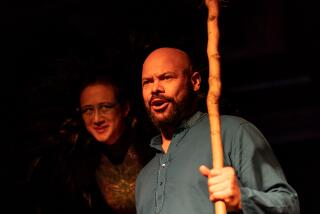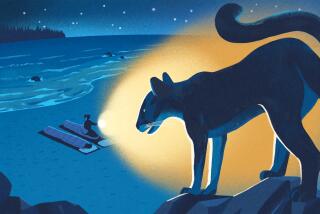Memories of mired mammoths and swooping vultures as schoolchildren mark geologic time in Tar Pit essays
- Share via
I hadn’t been out to the La Brea Tar Pits in years, probably because I always have the feeling they will keep.
After all, they’ve been there 40,000 years, give or take a millennium.
But the pits are certainly our No. 1 natural wonder, and the 10-year-old Page Museum is a handsome theater for their display, enhancement and preservation.
I had been invited to judge essays by third- to sixth-graders on the subject of their visits to the museum.
I met in a back room with my fellow judge, Rita Walters, president of the Board of Education; the third judge, Dr. George Fischbeck of KABC-TV, couldn’t make it, but he had sent in his selections.
It must be easier to pick a Nobel laureate than to judge among essays written by schoolchildren. First one is carried away by sheer imagination, then seduced by the improbable achievement of order, perception and syntax.
I’m afraid I was more carried away by imagination than anything else.
The children had been warned not to write about dinosaurs, which are what most children think about when they think about prehistoric animals. But the dinosaurs died out 60 million years ago. They were not contemporary with the saber-toothed cats, dire wolves, imperial mammoths, giant ground sloths, camels and western horses that populated the Los Angeles plain in the Ice Age.
Most of the essays were blood curdling. Nature is red of tooth and claw. With joyous enthusiasm the children described how the animals were deceived by the rainwater shining on the tar pits, walked out to get a drink, sank in the tar and then were pounced on by cats and vultures, which also sank in the tar to be preserved for today’s children and paleontologists to marvel at.
The children especially seemed to like the vultures, or buzzards.
Wrote sixth-grader Aaron Baker of Meadows School in Manhattan Beach, “The saber-toothed cat arrived at the water hole, stepped in to get a drink, got stuck in the tar, and the buzzard attacked him. . . . “
Briana Pullen, also a sixth-grader at Meadows, imagined that she herself was a saber-toothed cat trapped in the tar: “I ran fast and when I came to the pool I pounced on the bison. Suddenly . . . I realized I was sinking. Some vultures were flying above. One swooped down on me, then he realized that he too was sinking.”
Taraneh Tehrani, sixth-grader at Meadows, imagined herself as a human being, perhaps the 9,000-year-old woman whose bones were found in the tar and whose flesh is reincarnated on her skeleton every 30 seconds in the museum’s most eerie exhibit:
Showing human fear and compassion, Tehrani wrote: “I am mostly afraid of the big animals. Like the mammoths and the saber tooth tigers. I’m not afraid of the rabbits. Actually I feel sorry for them when they die in the tar pits or become a vicious vulture’s next meal.”
Chi Hyunh, third-grader at Williams School, Rosemead, not only showed that she knew about geological time and its consequences, but also that she could write a simple, brief, declarative sentence:
“Long ago there was a little land but lots of water. Many plants grew in the water. Many days passed. The trees and plants had died. Some days there were earthquakes. Much dust covered the trees and plants. Many generations had passed. More dust and sand had covered the dead trees and plants. As more dust and sand covered the other dust and sand the earth layers began to get heavier and heavier. If the earth is getting heavier and heavier, think of the plants that are underneath it. The plants that are under the dirt had been smashed and smashed. They formed into two different kinds of things. One was coal. If you break open a coal you will sometimes find a pattern of a leaf. The other was tar.
“Tar and oil lay in the ground. Sometimes there are earthquakes. If there are earthquakes they can crack the layers. The tar splashed up and made a puddle of tar. Some day it rained. The rain sat on top of the tar puddle. Some animals, like camels, wild western horses, dire wolves, mammoths, ground sloths and mastodons came to drink water. They got stuck in the tar pits. Other animals like the saber tooth cat saw the stuck animals. It jumped over the animal and got caught itself. They all died and if the vultures saw the dead animals they would clean up the dead meat.
“Many people found lots of animals’ bones that got stuck, but only one Indian was found in the tar. That was a girl.
“There is more but this is why we know about animals from long ago.”
At 11 a.m. they held a ceremony out in the main room of the museum. Since it was a Saturday, there were many visitors, including children. Mrs. Walters and I introduced the winners over the microphone. I announced that Chi Hyunh had won first prize in the essay contest, but I didn’t know how to pronounce her name so I spelled it.
There was a cheer from a little group standing a few feet from the lectern and Chi Hyunh was pushed forward. She came to my side shyly, about four feet tall.
I asked her how to pronounce her name. She told me, but I couldn’t quite get the hang of it.
“What language is that?” I asked her.
She said, “English,” and shrugged her shoulders as if to add, “What else?”
More to Read
Sign up for Essential California
The most important California stories and recommendations in your inbox every morning.
You may occasionally receive promotional content from the Los Angeles Times.










